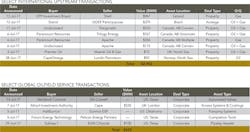Deal makers hunt for the next hot play amid a volatile crude market
ANDREW DITTMAR, PLS INC., HOUSTON
AFTER A YEAR of breakneck activity, US upstream deal markets look set for a slower, more relaxed pace through the second half of 2017 as companies try to guess the next hot play while navigating a crude market with many conflicting signals. This follows a run since the start of Q3 2016 when $91 billion in assets transacted, with just about one-half of that-$45 billion-coming from the Permian mania that swept the industry. However, a shift in direction for the markets was already visible during Q2, with the Permian notching just under $3 billion in deals. That was its lowest total since Q1 2016 and down 85% from the high of $18.4 billion recorded in Q1 2017. There are a number of reasons for the Permian slowdown, with perhaps the biggest driving force simply the number of deals already struck, especially in the Delaware Basin, leaving fewer available acquisition targets. In addition, renewed crude price volatility widens the bid/ask spread and makes it tougher for buyers and sellers to come together on price.
Despite the slowdown, there are still buyers interested in the right Permian package as demonstrated by Carrizo's acquisition in June from ExL Petroleum. This premium Delaware Basin position covered 16,500 net acres offsetting the land acquired by Centennial Resource Development from Silverback Exploration in November 2016. Carrizo paid close to $26,000/acre for the leasehold with the potential for that to rise as high as $33,000/acre if a contingent payment linked to oil prices fully pays out.
As the rush into the Delaware Basin fades, several areas have emerged as the next potential center for deal activity. Permian areas outside the core Midland and Delaware basins have been popular-the Central Basin Platform in particular. This area has seen increasing interest as operators test the potential of the San Andres for modern horizontal development. Gary Evans and many of the old team from Magnum Hunter apparently like what they see, picking up nearly 10,000 acres in Cochran County in mid-July for their new company, Energy Hunter. While acreage costs and deal values have been moderate, deal volume has picked up significantly with nearly 10 Central Basin Platform transactions since the start of the year. This could be a run-up to a rapid takeoff in deals if well results come in strong. However, given shaky crude prices, any potential land rush seems likely to be delayed for some time.
The Powder River Basin is another area that has garnered considerable industry chatter as the next potential hot spot with operators like Chesapeake reporting strong well results in a number of formations. The Powder River Basin once before seemed poised for a takeoff before the oil price downturn caused operators to pull back.
One of the most surprising developments of 2017 has been the lack of deal value reported in the SCOOP/STACK, which has yet to have a disclosed transaction over $100 million. At the start of 2017, these plays, along with the even newer Merge, looked best positioned as the heir apparent to the Delaware given strong well results, public company interest, and potential private equity-backed sellers. Despite the lack of big reported deal values, leasing and drilling activity has remained active, and there have been a few sizable deals that did not have a reported value. Significantly, Citizen Energy and Linn Energy agreed to combine their positions in the SCOOP/STACK/Merge to create a new pure-play-Roan Resources. This new E&P will have a 140,000 acre footprint and a targeted IPO in 2018 contingent on market conditions.
With the continuing uncertainty on crude prices, deal flow is likely to focus on assets with the lowest geologic risk: either established conventional assets or mature unconventional resource plays. This was apparent during Q2, with a resurgence in interest in older gas fields located in the San Juan, Piceance, and Green River Basins. Close to the end of the quarter, Occidental added to its established Permian EOR business via a $600 million acquisition from Hess. It offset this deal with sales of unconventional assets in areas of the Permian outside the company's core focus. The mature (as shale plays go) Bakken grabbed the first billion-dollar-plus deal of Q3 when Bruin E&P Partners bought $1.4 billion worth of assets from Halcon. Much of this was likely acquired for production value, with undeveloped acreage only paid for in the core Fort Berthold area.
Outside the US, upstream markets continue to be driven by international oil companies selling assets to private capital or smaller players. Apache announced it is exiting Canada completely after more than 20 years in the country via a series of deals with local E&Ps. Shell is selling its Irish gas business to the Canada Public Pension Plan Investment Board. Oilfield services deal flow may also take a hit during the second half of the year. It has been widely expected that service costs are due for a ramp-up, but with talk of US E&Ps slowing down and perhaps even dropping rigs, this looks less likely.


